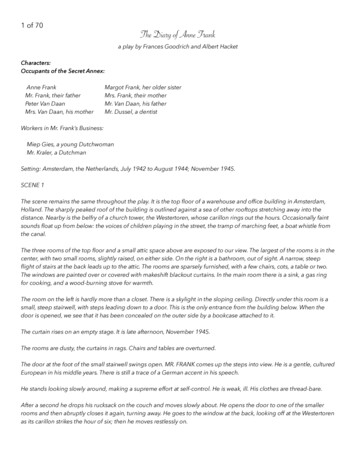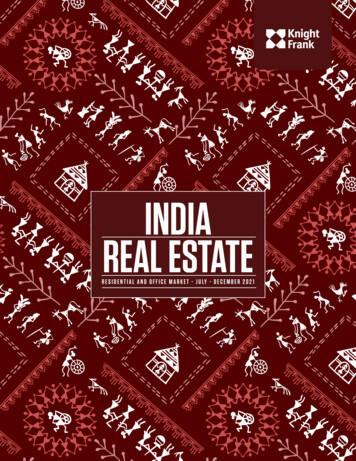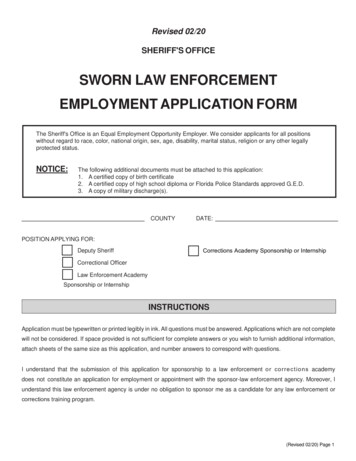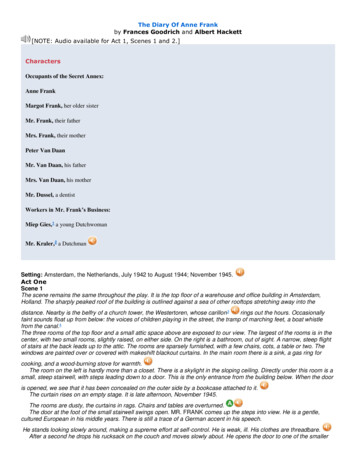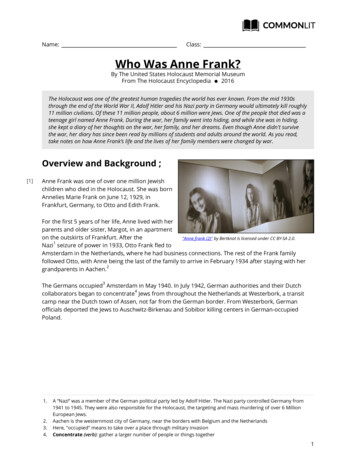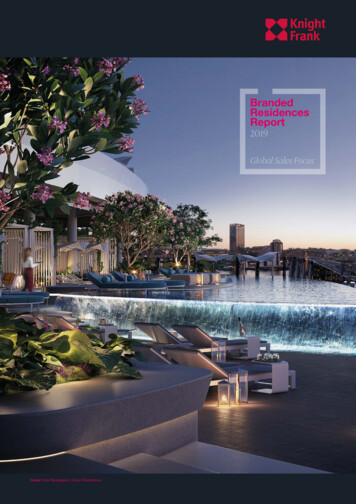
Transcription
Branded Residences Report 20191BrandedResidencesReport2019Global Sales FocusCover: One Barangaroo, Crown Residences
Branded Residences Report 2019Branded Residences Report 201923GLOBAL BRANDEDRESIDENCESWhat defines a branded residence?As branded residences proliferate, from the Caribbean to China, a growing number of developers, hotelgroups and investors are looking to capitalise on this opportunity. But just what are branded residences,what underpins their appeal, and what is driving the rapid expansion and diversification of this sector?The evolution of branded residenceshe first true branded residence,the Sherry-Netherland hotel inManhattan, opened its doors in1927. More than 90 years on, the sector hasgrown enormously and is now to be found inover 60 countries across the globe.Our research shows that there are nowover 400 branded residences across theglobe, the majority of which are hotelbranded. Growth in the sector showslittle sign of abating: “Marriott alonehas more than 60 branded residentialprojects in the pipeline,” says Daniel vonBarloewen, Regional Senior Director forMixed-Use development for Europe atMarriott International. In 2018 and 2019alone, Marriott plans to open 19 brandedTresidential projects in nine countries.The birth of the branded concept can betraced back to the prolonged economicboom of the 1920’s in America. Indeed,across the years, there is a direct correlationbetween wealth creation and demand forbranded residences.Much of the sector’s expansion hasoccurred in more recent decades. “Themarket did not really take-off until themid-1980s when Four Seasons openedcondos next to their hotel in Boston. Thatreally demonstrated the success of themodel,” says Chris Graham, an expert onthe sector. The Aman hotel group launchedthe concept in a resort setting in 1988, withAmanpuri in Phuket, Thailand.It is no coincidence that we are seeing sucha renewed interest in the branded conceptgiven the rapid growth in global wealthwitnessed since 2000. Knight Frank’s WealthReport highlights that the global ultra-wealthypopulation ( 50m in net assets), grew by18% in the five years up to 2017 and is forecastto increase a further 40% over the next five.With the branded concept well establishedby hotel operators, the number and typesof operators entering the space is nowexpanding and diversifying. Brands such asVersace, Armani and Porsche have all lenttheir names to developments in recent years.In this report, we look at the different types ofbranded residence, the rationale behind theconcept, global exemplars and future trends.The traditional branded concept is a hotelled development with integrated or linkedresidences. They naturally benefit fromthe hotel brand (quality), management(smooth running) and services (luxury). Inessence, this gives the owner the comfortand permanence of a home but with the fullbenefits and luxury of a five-star hotel.This concept has diversified so that it can beoffered more flexibly across varying marketsand locations and now manifests itself inmany ways globally, which fall into five broadcategories, as demonstrated below.While every scheme is different, onecould argue that the impact of the brandedconcept is diluted the more it moves awayfrom the original hotel-driven traditionalmodel.“Our research shows that thereare now over 400 brandedresidences across the globe,the majority of which are hotelbranded”TypographiesHotel led developmentswith integratedresidencesLuxury resorts withresidences used asholiday letsResidential leddevelopments with hoteladjacentResidential developmentswith hotel managementResidential developmentswith remote hotel tie inTimeline of the branded residence1927Sherry-Netherlandhotel opens in New Yorkmarking the birth of theconcept1985Four Seasons opens itsfirst branded privateresidences in Boston1988Aman launches thefirst resort brandedresidence withAmanpuri in Phuket,Thailand2011The Residences atMandarin Oriental,London were completedsetting a new worldbenchmark for luxurybranded residences2000-2018Rapid expansion to over400 projects by 2018Top left: The Royal AtlantisResort and Residences, DubaiLeft: Amari PhuketResidence, PhuketAbove: Mayfair ParkResidences, managed by theDorchester Collection
Branded Residences Report 2019Branded Residences Report 201945VALUE DRIVERS ANDPRICE PREMIUMSSupply and Demand Value DriversIn order to understand the value drivers of branded residences, below we examine the keymotivators from both providers (supply) and purchasers (demand).One Barangaroo, Crown ResidencesSupply SideDemand SideHotel development cash flowRisk mitigationValue premium of brandPlanning benefitsDeveloper quality covenantService provision and physical amenitiesBuilding maintenance and managmentThe ability to sell residencesoff-plan and receive significantcapital payments upon practicalcompletion, assist with bothdevelopment and operationalcash flow as hotels will naturallytake time to operate at optimaloccupancy rate.Residences can help off-setcyclical and seasonal variations, aswell as extraordinary events thatpose a risk to any hotel business,both in terms of occupation andadditional service take up.“Brand involvement can increaseproject visibility and enhancevalues for residential developers.This can be something of aninsurance policy,” says JamesSnelgar, director of global businessdevelopment at YOO.The addition of residentialapartments can be politicallyfavourable where the delivery ofapartments into a marketis a priority.“When buyers see marketing for a Ritz-Carlton,St Regis, EDITION or Marriott residence,they know that they’re going to get a qualityproduct,” says Daniel von Barloewen.“Residents’ services offer the individuals theopportunity to preserve their most preciouscommodity - time,” says Todd Nisbet, CrownResorts. As individuals increasingly becomeglobal citizens with diverse business interests,time is becoming a rare commodity. With a fullhospitality offering, individuals know that theday-to-day necessities are taken care of,be it housekeeping, concierge facilities,or room service.”James Price, vice president of residential atFour Seasons, adds it is the “managementservices and guaranteed building maintenancewhich also enhances value.” Nisbet adds thathospitality brands are “always re-investing andmaintaining their brand.”Market differentiationResidential identity/critical massValue/Cost benefitLock up and leave optionHoliday rental/Investment yield potentialKudosOn a per square foot capital valuebasis, residential accommodationcan drive a higher value thanhotel accommodation. Therecould also be cost savings throughgreater efficiencies across gross/net area ratios and specificationrequirements.Global buyers are prepared to pay a premiumwhere they know their property is safe,maintained and serviced in their absence. Thisranges from technical maintenance to havingfresh flowers upon arrival.“Often there’s a rental pool, which meansowners can offset their maintenance costs.Now, 60-80% of buyers put their property inthe rental pool, which is double what it mighthave been 10 years ago,” says Muriel Muirdenof WATG. According to Price, the rentalprogrammes tend to be a bigger driver in resortlocations as those buying in cities tend to usethem more regularly.When all is said and done, people will alwaysvalue a badge that is universally respected andthat reflects well upon them.Product diversification andbrand enhancement“For a hotel operator, residencescan be a new theatre for the brand;a way to deepen the relationshipwith the consumers,” explainsPiers Schmidt, a luxury brandconsultant and commentator atThe Luxury Branding.In mature or saturated markets,or where developers are lookingto set new price records, brandingand service can therefore be a keydifferential.A new hotel can significantlyenhance areas with limitedresidential identity or services.The sales appeal of a residentialscheme in a commercial area, butwith a trophy hotel attached, is farstronger.Does this mean that having a brand results in a price premium?hile a brandassociation mayresult in a premiumin any region, the additionalvalue varies substantially fromone place to another. “Whereit’s an entirely new offering,we might be two or threetimes the price of anything inWthat market. In other marketsthere will be price ceilings,”says Price. “A variety of factorscan drive price premiums,”adds von Barloewen. “MarriottInternational has, for example,Ritz-Carlton-brandedresidences in Kazakhstan andBvlgari-branded residencesin Dubai that commandedsignificant premiums forthe developer over luxury,residential product in thosemarkets.”It is important to note that aprice premium can be locationdriven. Indeed, our researchshows that there is greatvariation on price differentialsbetween different globallocations and also differentlocations within cities.The data shows that the pricedifferentials can vary from asmuch as 132% in some citiesin Asia, to there being nodifferential at all.Erin van Tuil, Partner atKnight Frank notes that“while the branded conceptin the Sydney market is stillembryonic, all the evidence wehave to date from marketingOne Barangaroo is that apremium of 25% to 35% aheadof comparable non-brandedproduct is where the marketwill sit.”However, assessing a pricedifferential is extremely difficultas there are few cases thatcontrol for every factor affectingprice. For a true comparisonthere would need to be abranded residence in the samelocation as a comparable nonbranded, with the same exteriorand interior design.A deep understanding ofmicro markets is required inasessing the business casefor any branded concept. Putsimply, will the market pay apremium and why?
Branded Residences Report 2019Branded Residences Report 201967GLOBALLY MAPPEDThe wide and expanding reach of the branded residence concept, mapped.o build a globalpicture of brandedresidences we havelooked at some of the industry’sbiggest hotel operators includingMarriott, Four Seasons, AccorHotels and many more. TogetherMarriott, Four Seasons and AccorHotels represent over half of allhotel branded residences, withMarriot alone accounting forthree-quarters of these. The mapdemonstrates the geographicalexpanse of the concept withhotel branded residences presentin over 180 locations across 64countries globally.As the concept originated inNorth America, it is no surprisethat this market is the mostdeveloped and has the largestpresence, accounting for a thirdof all schemes. However, theAsian market for hotel brandedresidences has seen stronggrowth, particularly in Thailandand Indonesia, with Asia nowaccounting for an estimated 30%of schemes. This trend is set tocontinue, “Asia is the continentof opportunity: there’s a growingmarket and rapid urbanisation,”says Muriel Muirden,executive vice president at thearchitectural firm WATG.At a more localised level, as asingle city, Dubai is where thereTis the highest concentrationof branded residences. Withoperators such as KerznerInternational, The Address,The W, Jumeirah and Bvlgarientering the branded residencemarketplace, from resort livingon the Palm Jumeriah to urbanconcepts close to DowntownDubai and the FinancialCentre (DIFC). According toPiers Schmidt, a luxury brandconsultant and commentatorat The Luxury Branding, “theexplosion of development inDubai is down to the fact thatdevelopers and promoters havea need to differentiate: you canbuild it taller, make it revolveand shimmer, but when you getinside an apartment, having abrand gives an advantage.”One region in which thebranded concept is still quitesmall is Europe, accountingfor only 7% of brandedresidences. In Europe thereis “less demand for brandedthings, period,” according toSchmidt. “Developers are lessprone to license a brand to movetheir real estate [in Europe]because they know their assethas appeal,” he adds. Howeveras residential markets becomemore competitive Europe maybe another area of growth.Urban livingThe branded concept is a predominantly urban concept, with 62%of hotel branded residences in cities as opposed to beach/resortlocations. However, this does vary by region. In North America,two-thirds of schemes are in cities, whereas in Asia it is much morebalanced, with almost half being in resort locations.As the market continues to expand it is expected that developmentsare likely to concentrate in urban areas. Across the global economythere is a huge shift towards major urban hubs, for example Aman,the first resort brand, is now moving towards the urban space. This isdriven by the less seasonally affected demand in urban centres.“Hotel branded residencesare present in over 180locations and 64countries globally”Over 10010 to 50Under 10
Branded Residences Report 2019Branded Residences Report 201989LOCATIONS IN FOCUSWe spoke to four leaders in Knight Frank’s global network on their marketplace for branded residences.“New YorkHotel brandedresidences have beena key segment of New YorkCity’s luxury market since theoriginal hotel serviced residentialapartments at The SherryNetherland and The Carlyle.The early 2000’s saw aresurgence of large-scalehotel-branded condominiums,notably the opening of TheResidences at Mandarin OrientalNew York in 2003 as part ofthe mixed-use Time WarnerCenter development perchedon the prime southwest cornerof Manhattan’s Central Park.This revival reflected the rapidexpansion of global wealth andthe focus of New York as a keyglobal city for high net worthindividuals.In the 15 years since, a numberof hotel branded condominiumdevelopments have createda popular niche in the primeand super prime developmentmarket. While previouslyclustered in historically primeneighbourhoods on the UpperEast Side and Midtown, newhotel branded developmentshave now extended into theprime Downtown market.Midtown’s Baccarat Hotel andResidences, which sold out in2017, boasts the world’s firstBaccarat Hotel and views ofCentral Park. With the crowningduplex penthouse selling formore than 42 million in 2016,condominium residents herehave access to five-star hotelservices and amenities.”“DubaiIn a city renowned forits plethora of 5-starhotels, the emergence of brandedresidences in Dubai has becomeincreasingly common.In recent years Dubai hastransitioned from a holidaydestination, to a city in whichto invest in a more permanenthome. The global citizen islooking for a more sophisticatedoffering in Dubai that willelevate their living experienceto incorporate not only greatdesign and architecture butalso the benefits of resort livingprivate beaches, spa facilities,concierge and Michelin-starredrestaurants.The branded residence offeringin Dubai has raised the bar evenfurther, with its first super-primedevelopment. Located on thePalm Jumeirah, directly adjacentto the iconic Atlantis The Palmresort, The Royal AtlantisResort and Residences provide aselection of 2, 3 and 4 bedroomapartments, penthouses andgarden suites. Not only doesthe development benefit fromall the world-class amenitiesand experiences that one wouldexpect from a best-in-classhotel, it also occupies one of theworld’s most prime locations inglobal real estate terms and isset to become the new icon ofDubai.”“The early 2000’s saw a resurgenceof large-scale hotel-brandedcondominiums”Maria Morris, Knight FrankAndrew Wachtfogel,Douglas EllimanBaccarat Hotel and ResidencesThe Royal Atlantis Resort and Residences“The global citizenis looking for amore sophisticatedoffering in Dubai”
Branded Residences Report 2019Branded Residences Report 20191011“One Barangaroo,Crown Residencesmarks the introduction ofhotel branded residences inAustralia. The arrival of brandedresidences at this time intoSydney is no coincidence.Sydney continues to attracthigh net worth individuals(HNWIs) by taking up asignificant proportion of the10,000 HNWIs net inflowinto Australia each year, thehighest of any country, forthree years running as reportedby New World Wealth. Thisdemonstrates Sydney as arapidly advancing global city.Since the global financial crisisin 2008 Sydney has seen stronggrowth in prime property prices.The lack of exceptional stockhas plagued the top end of themarket, lifting prices as demandcontinues to increase.One Barangaroo, CrownResidences, as the country’s firstfully integrated, six-star hotelbranded residences, has receiveda very warm welcome fromboth Australian and offshorepurchasers alike since salescommenced. The driving forcebehind the on-going interest isa combination of the lifestyleoffering as well as the design andlocation.The full suite of hotel-styleconcierge services, in-roomdining, priority booking at therestaurants within the buildingand the private residents’pool deck, means that theCrown Residences have set thebenchmark high for Australiaand will compete on a globallevel to both investors andresidents alike.The Wilkinson Eyre designedbuilding will be globallyrecognisable and with floor toceiling windows throughout, willoffer iconic views over SydneyHarbour Bridge and the OperaHouse.”“Crown Residenceshave set the benchmarkhigh for Australia andwill compete on a globallevel to both investors andresidents alike”Above: Twenty Grosvenor Square, Four SeasonsLeft: The Residences at Mandarin Oriental Mayfair, LondonBelow: The OWO (The Old War Office), Raffles“SydneyLondonSince a globalresidential benchmarkwas set at One Hyde Park, thefirst European residences at theMandarin Oriental, the Londonmarket has seen an increase inbranded residences at the topend of the market. While manyprime residential developmentsactually offer the service level andamenity akin to hotels, both hoteland residential developers haveidentified London as the globalcity of desire for ultra high networth individuals and are lookingto take advantage of this focus.”Alexander Lewis, Knight FrankErin van Tuil, Knight FrankOne Barangaroo, Crown Residences
Branded Residences Report 2019Branded Residences Report 20191213THE FUTURE OUTLOOKAs branded residences multiply globally, how and where is the sector expected to grow and diversify?What are the potential risks and rewards for developers, brands and buyers as it does so? And in an ageof high customer expectation and the on-demand economy, how will branded residences meaningfullydifferentiate themselves from the competition?Expansive demandranded residences, until the1980’s a scarce commodity butcan now be found in almostevery major city and major holidaydestination. Having extended its reach,the sector is growing exponentially. Themajor hotel brands dominate and expand.However, smaller hotel groups are enteringthe market and, recently, luxury brandsoutside hospitality have lent their namesto new developments. This adds a newdimension to the concept, one with anemphasis on pure association rather thana proven service record.The sector’s growth has been such that,in some areas, the development typehas almost become ubiquitous. Theywere once “the exception rather than therule,” says Chris Graham, an expert onbranded residences, “but look at Thailandtoday, where almost 40% of all newdevelopments are now branded.” “MarriottInternational sees demand for colocated residential product in the luxuryand uppermost tiers gaining traction,”says Daniel von Barloewen of MarriottInternational. “The company expects toexpand its branded residential portfolioBby more than 70% in the next four years.”“From a consumer perspective, thepower of brand identification is onlygrowing,” says James Snelgar, head ofbusiness development at YOO. “The worldis becoming increasingly design consciousand brand aware. We talk about appealingto ‘a tribe’ of like-minded people, peoplewho want to live and socialise with otherpeople with whom they share things incommon,” he says.As well as reaching into new territories,hotel developers are attempting toexpand their customer base. “We areseeing an increasing demand now fora more affordable offer catering forthe millennials,” says Snelgar. Resortdevelopers in particular, says Muirden,“are looking at the behaviour of millennialparents and what they want: they reallywant a good, well rounded experience fortheir kids.”Different offeringsIncreasingly, operators are looking atexperiences, rather than just servicesor facilities, as a way to tempt buyers.“The hospitality industry has gone verymuch from the tangible to the emotional.It used to be “we can offer more: biggerpool, bigger gym etc. Those features havepretty much become a given. There areonly so many gold taps and marble youcan put into a residence,” says Graham.Now, “it’s about creating memories andan emotional link: bringing in a celebritychef or cocktail maker, arranging a cycletour,” he adds. “The focus,” echoes Snelgar,“is now becoming more experienceorientated: for example cooking, climbingor diving.”“As well as diversifying the activitiesthey offer, resorts will need to differentiatethemselves: they’ll need to be moreeco-focused in design and operation.Branded residences will have to be farmore holistic, with beautiful gardens anda wellness focus, as well as being moremulti-generational,” says Muriel Muirdenof WATG.With a crowded market providing theimpetus to differentiate, developers arealso aligning with renowned brands formore and more aspects of any residentialproject. The model originated with hotelslending their name to developments. TheThe future of the branded residence2018onwardsMarket growthPotential new offerings andtechnologies to cater fordifferent demographicsMore experiences, rather thanservices or facilitiesnext stage saw the arrival of designers –such as Philippe Starck, who co-foundedYOO. “Following the designers have beenthe ‘starchitects’: Daniel Libeskind, FrankGehry, Norman Foster and César Pelliamong them. In some cases, as developersstrive to raise the bar, you can now endup with two or three brands on a singledevelopment. The Armani residencesin Miami has Giorgio Armani doing theinteriors and Pelli doing the exterior,” saysGraham. These brands are being pushedforward as part of a scheme’s identity,rather than just a component part of thephysical product.Positive outlookThe growth of the sector will not bewithout potential pitfalls. There is adanger that in democratising the conceptof branded residences, developers alsorisk devaluing it. The concept has alwaysbeen aspirational. Now hotel companiesare offering brands at a 4-star level also.That risk may be unlikely to stalldevelopers, however, with industrycommentators saying that it is unlikelythat we are going to move to a world wheresuddenly buyers are no longer concernedwith the offerings of branded residences.The market will undoubtedly get morecompetitive, and there will be a fewdevelopers and brands squeezed out asa result, but that is unlikely to stop themtrying to capitalise on a market which stilloffers substantial benefits. The crucialquestion, as Graham puts it, is this: “thebar gets raised every year – more facilities,more experience, more tech: if everyone’sdoing that, how are you going to to offersomething different?”More eco-focused in designand operationOne Barangaroo, Crown Residences“Increasingly, operators are looking at experiences, ratherthan just services or facilities, as a way to tempt buyers”
Branded Residences Report 2019Branded Residences Report 20191415DEVELOPING VALUEHow Knight Frank’s consultancy services canadd value to developmentsThere are wide ranging factors that determine the value placed on hotel branded residences and thesefactors must be considered at all stages of planning and development. Understanding what drives decisionsis key to optimising profit. This is an area of focus for Knight Frank’s consultants across the globe.Erin van TuilPartner, One Barangaroo,Knight FrankMaria MorrisPartner, Residential Sales,Knight FrankCarolyn SebbaSenior Vice President, DouglasElliman* Development MarketingAlexander LewisPartner, ResidentialDevelopment Consultancy,Knight FrankGlobal networkIn-depth marketData and insightAdvice on whichSpatial planningMarketingwith a presence inresearch to provideon buyerservices andand mix analysisstrategies60 territoriesglobal benchmarkspreferencesamenities add value“Luxury is expected from our clients; the most important element is howto raise the bar across every aspect of the overall offering”Maria Morrisefore any residence is broughtto the market there are years ofwork; from concept planningthrough to detailed design. Maria Morrisstates that the consultancy servicesprovided by Knight Frank throughout theprocess “optimise the residential offeringby aligning every aspect of the residencewith what the buyer is looking for.”Wealthy individuals buy hotel brandedresidences as a lifestyle option but alsowith an eye on capital appreciation.Carolyn Sebba comments that high-endhotel brands represent “prestige, an extraordinary level of services, aspirationallifestyle and convenience.” In addition,Morris notes that is also important toensure that the brand is right. “It is simplefor a developer to enter in to a licenseagreement with any operator, but for thebranded residences to be exceptional, it hasBto be the right operator that aligns with thelevel of service that buyers expect.”The lifestyle component of hotelbranded residences is key to buyers’decisions. Erin van Tuil remarks that hotelbranded residences offer “ease of livingthrough having all of the facilities on yourdoorstep,” van Tuil continues that “a hotelconcierge offers a different service thanwhat you can find in serviced apartments.For example if you want to organise asommelier or private chef they can do thatfor you - a normal concierge wouldn’t.”Sebba adds that the list of servicesavailable are endless and hard to replicateoutside this space, “for example, amenitiesinclude having a butler service, aseamstress, translation services, personalshopping, flower delivery, catering, childcare, and all of these are on call.”However, the added facilities aloneare not enough to create a best in-classresidence. All aspects relating to theresidence must be considered carefullyand each stage in the developmentprocess interrogated as to what is goingto add the most value to the buyer.“Having the right architecture, rightlocation, superior interior designers, andextras, such as landscape gardening,marry together as real value drivers,”notes van Tuil. “In my view, it has tohave a combination of great designand tremendous architecture, top classinteriors, plus the right amenities andexperiences. Luxury is expected from ourclients; the most important element is howto raise the bar across every aspect of theoverall offering,” adds Morris.“There are some more practical elementsthat need to be analysed in the conceptphases as well,” highlights AlexanderLewis. “In the first instance, you have toremember that you are still designing aresidential scheme. Space and functionwill always outsell frills. Scheme conceptand space planning, from building formto detailed layouts, must be perfect.Branded residences can also throw upproblems such as onerous service chargesand security issues. Cost control andspecification analysis is also critical in aninflationary environment.”“Designers can get carried away with allthe niceties and latest gadgets,” adds vanTuil. “Focus must be on what the buyerplaces value on, not just expensive gimics.”Morris remarks that our work can “ensureevery project is designed with the end userin mind, which is crucial in an increasinglycompetitive global marketplace.”She continues saying that “we offerconsultancy services from conceptionthrough to completion. Our goal is to addvalue to the entire development chain,from spatial planning and mix analysis,through to advising on the amenitiesrequired in each building.” Sebba addsthat “with access to an immense network,including high and ultra high net worthclients, we can provide in-depth marketresearch, intelligence from the brokeragecommunity, knowledge of the market andbuyer preferences, all valuable input tocreate the perfect design, amenity andservice offering.”“Good hotel design and good residentialdesign do not always go hand in handthough, as they are both specialisedmarkets that until recently have remainedseparate, and sometimes follow opposingprinciples. Design grids, service runs,basement requirements and external lighttreatment may all conflict and a key partof our job is working with different designdisciplines to ensure the value of bothhotel and residential are optimised,” addsLewis.“Most importantly,” van Tuil concludes,“we work as a global team. Brandedresidences cannot be designed in isolationwithout considering global exemplars. Notonly the residences, but the hotel brandsthat lie behind them. The reality is that ourclients, whether they are buying in Dubaior Sydney, will have likely experienced thevery best across continents. They will becomparing a scheme offered in Londonto one offered in New York. Our greateststrength as a firm is working together toensure our clients schemes are globallycompetitive.”* Knight Frank’s residential alliancepartner in the United States
Branded Residences Report 201916Contacts – ResearchLiam BaileyGlobal Head of Researchliam.bailey@knightfrank.comFlora HarleySenior Research Analystflora.harley@knightfrank.comContacts – Residential SalesSydneyErin van TuilPartner, One Barangaroo, Crown a MorrisPartner, Head of MENA exander LewisPartner, Residential Development – Consultancyalexander.lewis@knightfrank.comNew YorkStacey WatsonPartner, International Residentialstacey.watson@knightfrank.comImportant Notice Knight Frank LLP 2018 – This report is published for general informationonly and not to be relied upon in any way. Although high standards have beenused in the preparation of the information, analysis, views and projectionspresented in this report, no responsibility or liability whatsoever can beaccepted by Knight Frank LLP for any loss or damage resultant from any
The Residences at Mandarin Oriental, London were completed setting a new world benchmark for luxury branded residences 2000-2018 Rapid expansion to over 400 projects by 2018 The traditional branded concept is a hotel-led development with integrated or linked residences. They naturally benefit from the hotel brand (quality), management
